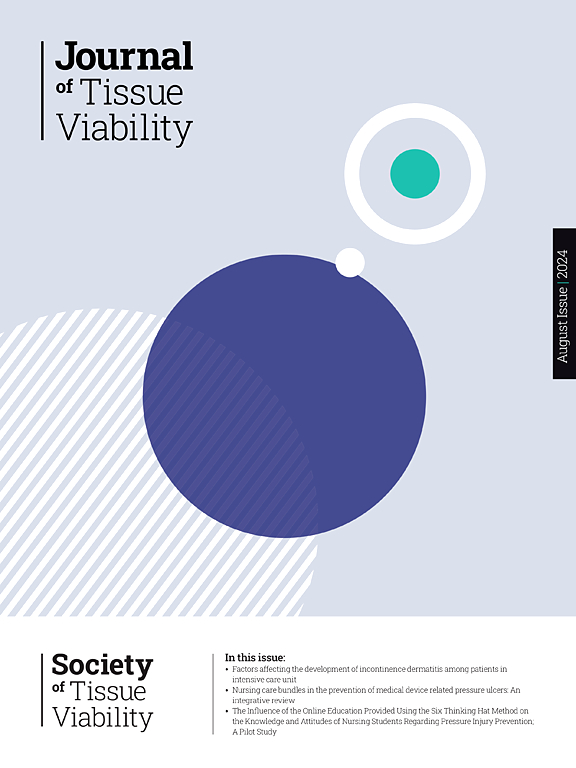循证皮肤护理和水胶体敷料对预防鼻胃管相关压力损伤的效果:随机对照临床试验。
IF 2.4
3区 医学
Q2 DERMATOLOGY
引用次数: 0
摘要
本研究旨在确定循证皮肤护理和水胶体敷料在预防鼻胃管相关压力损伤 (PI) 方面的效果。本研究是一项三臂平行组随机对照临床试验,已在 Clinicaltrials.gov (NCT04682925) 上注册。患者被随机分配到三组:对照组(34 人)、水胶体敷料组(34 人)和皮肤护理组(34 人)。水胶体敷料组患者每天在鼻粘膜和插入 NG 管的鼻翼处使用水胶体敷料。皮肤护理组的患者每天两次接受皮肤护理干预,以预防PIs。结果 水胶体敷料组患者未发生与 NG 管相关的 PI。但是,对照组 97.1% 的患者和皮肤护理组 94.1% 的患者发生了 PI。回归分析结果显示,未使用水胶体敷料会使 NG 管相关 PI 的风险增加 20.3 倍[OR = 20.301,95 % CI = 6.335-65.053,p < 0.001]。此外,通气天数每增加一个单位,NG 管相关 PI 的风险就会降低 17.7% (1-0.823) [OR = 0.823 (95 % CI = 0.684-0.989), p = 0.038]。本文章由计算机程序翻译,如有差异,请以英文原文为准。
The effect of evidence-based skin care and hydrocolloid dressing in the prevention of nasogastric tube-related pressure injury: A randomized controlled clinical trial.
OBJECTIVE
The aim of this study is to determine the effect of evidence-based skin care and hydrocolloid dressing in the prevention of nasogastric (NG) tube-related pressure injuries (PIs).
DESIGN
This study was a three-arm parallel-group randomized controlled clinical trial registered on Clinicaltrials.gov (NCT04682925).
METHODS
The study was conducted with 102 patients who underwent NG tube insertion immediately after admission to the anesthesiology and reanimation intensive care unit of a university hospital in Turkey. Patients were randomly assigned to three groups: a control arm (n = 34), a hydrocolloid dressing arm (n = 34), and a skin care arm (n = 34). Patients in the hydrocolloid dressing arm received daily application of hydrocolloid dressing to the nasal mucosa and alae nasi where the NG tube was inserted. Patients in the skin care arm received skin care interventions in preventing PIs twice daily. No interventions were administered to the control group.
RESULTS
No NG tube-related PIs occurred in any patients in the hydrocolloid dressing arm. However, PIs occurred in 97.1 % of patients in the control arm and 94.1 % of patients in the skin care arm. According to the results of regression analysis, failure to apply hydrocolloid dressing increased the risk of NG tube-related PIs by 20.3 times [OR = 20.301, 95 % CI = 6.335-65.053, p < 0.001]. Additionally, a one-unit increase in the duration of ventilation days reduced the risk of NG tube-related PIs by 17.7 % (1-0.823) [OR = 0.823 (95 % CI = 0.684-0.989), p = 0.038].
CONCLUSION
Results revealed that hydrocolloid dressing is effective in preventing of NG tube-related PIs, whereas skin care did not demonstrate the same effectiveness.
求助全文
通过发布文献求助,成功后即可免费获取论文全文。
去求助
来源期刊

Journal of tissue viability
DERMATOLOGY-NURSING
CiteScore
3.80
自引率
16.00%
发文量
110
审稿时长
>12 weeks
期刊介绍:
The Journal of Tissue Viability is the official publication of the Tissue Viability Society and is a quarterly journal concerned with all aspects of the occurrence and treatment of wounds, ulcers and pressure sores including patient care, pain, nutrition, wound healing, research, prevention, mobility, social problems and management.
The Journal particularly encourages papers covering skin and skin wounds but will consider articles that discuss injury in any tissue. Articles that stress the multi-professional nature of tissue viability are especially welcome. We seek to encourage new authors as well as well-established contributors to the field - one aim of the journal is to enable all participants in tissue viability to share information with colleagues.
 求助内容:
求助内容: 应助结果提醒方式:
应助结果提醒方式:


